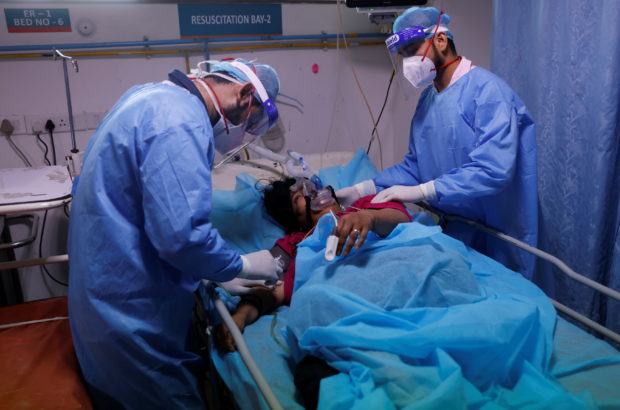
Medical workers tend to a patient suffering from coronavirus disease (COVID-19), as a Syringe Infusion Pump, donated by France is seen next to his bed, inside the emergency room of Safdarjung Hospital in New Delhi, India, May 7, 2021. REUTERS/Adnan Abidi
BENGALURU — India’s main opposition leader Rahul Gandhi warned on Friday that unless the deadly second COVID-19 wave sweeping the country was brought under control it would devastate India as well as threaten the rest of the world.
In a letter, Gandhi implored Prime Minister Narendra Modi to prepare for another national lockdown, accelerate a countrywide vaccination program, and scientifically track the virus and its mutations.
Gandhi said the world’s second-most populous nation had a responsibility in “a globalized and interconnected world” to stop the “explosive” growth of COVID-19 within its borders.
“India is home to one out of every six human beings on the planet. The pandemic has demonstrated that our size, genetic diversity, and complexity make India fertile ground for the virus to rapidly mutate, transforming itself into a more contagious and more dangerous form,” wrote Gandhi.
“Allowing the uncontrollable spread of the virus in our country will be devastating not only for our people but also for the rest of the world.”
India’s highly infectious COVID-19 variant B.1.617 has already spread to other countries, and many nations have moved to cut or restrict movements from India.
British Prime Minister Boris said on Friday the government needed to handle very carefully the emergence of new coronavirus strains in India that have since started to spread in the United Kingdom.
Meanwhile, tons of medical equipment from abroad has starting to arrive in Delhi hospitals, in what could ease the pressure on an overburdened system.
Vaccination rates
In the past week, India has reported an extra 1.5 million new infections and record daily death tolls. Since the start of the pandemic, it has reported 21.49 million cases and 234,083 deaths. It currently has 3.6 million active cases.
Modi has been widely criticized for not acting sooner to suppress the second wave after religious festivals and political rallies drew tens of thousands of people in recent weeks and became “super spreader” events.
His government – which imposed a strict lockdown in March 2020 – has also been criticized for lifting social restrictions too soon following the first wave and for delays in the country’s vaccination program.
The government has been reluctant to impose a second lockdown for fear of the damage to the economy, though many states have announced their own restrictions.
Volunteers and relatives prepare to cremate the bodies of persons who died due to the new coronavirus disease (COVID-19), at a crematorium ground in Giddenahalli village on the outskirts of Bengaluru, India, May 2, 2021. REUTERS/Samuel Rajkumar
Goa, a tourism hotspot on the west coast where up to one in two people tested in recent weeks for coronavirus have been positive, on Friday announced strict curbs from Sunday, restricting timings for grocery shops, forbidding unnecessary travel, and urging citizens to cancel all gatherings.
While India is the world’s biggest vaccine maker, it is also struggling to produce and distribute enough doses to stem the wave of COVID-19.
Although the country has administered at least 157 million vaccine doses, its rate of inoculation has fallen sharply in recent days.
India vaccinated 2.3 million people on Thursday, the most this month but still far short of what is required to curb the spread of the virus.
Record infections
India reported another record daily rise in coronavirus cases, 414,188, on Friday, bringing total new cases for the week to 1.57 million. Deaths from COVID-19 rose by 3,915 to 234,083.
Medical experts say the real extent of COVID-19 is likely to be far higher than official tallies.
India’s healthcare system is crumbling under the weight of patients, with hospitals running out of beds and medical oxygen. Morgues and crematoriums cannot handle the number of dead and makeshift funeral pyres burn in parks and car parks.
Infections are now spreading from overcrowded cities to remote rural villages that are home to nearly 70% of the 1.3 billion population.
Although northern and western areas of India bear the brunt of the disease, the south now seems to be turning into the new epicenter.
In the southern city of Chennai, only one in a hundred oxygen-supported beds and two in a hundred beds in intensive care units (ICUs) were vacant on Thursday, from a vacancy rate of more than 20% each two weeks ago, government data showed.
In India’s tech capital Bengaluru, also in the south, only 23 of the 590 beds in ICUs were vacant.
The test-positivity rate — the percentage of people tested who are found to have the disease — in the city of 12.5 million has tripled to almost 39% as of Wednesday, from about 13% two weeks ago, data showed.
Syed Tousif Masood, a volunteer with a COVID-19 resource group in Bengaluru called the Project Smile Trust, said the group’s helpline was receiving an average of 5,000 requests a day for hospital beds and oxygen, compared with 50-100 such calls just one month ago.
“The experts say we have not yet hit the peak,” he said. “If this is not the peak, then I don’t know what will happen at the real peak.”